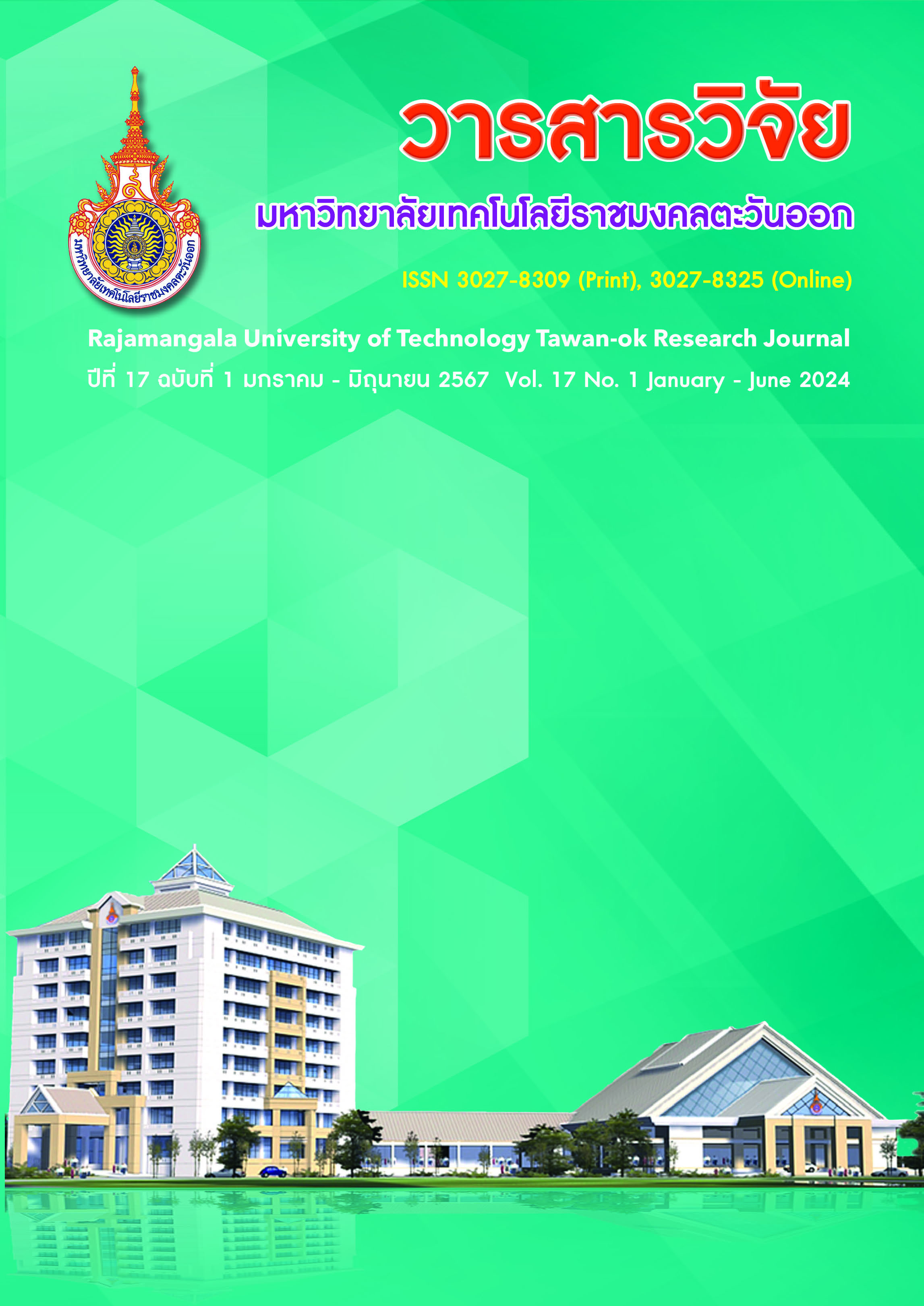ผลของการใช้ปุ๋ยอินทรีย์และการควบคุมวัชพืชต่อความหนาแน่นของวัชพืชในแปลงปลูกสับปะรด
Main Article Content
บทคัดย่อ
การศึกษาผลของการใช้ปุ๋ยอินทรีย์ต่อความหนาแน่นของวัชพืชในแปลงปลูกสับปะรด มีวัตถุประสงค์เพื่อศึกษาผลของชนิดและปริมาณของการใช้ปุ๋ยอินทรีย์ต่อความหลากหลายของชนิด ความหนาแน่น และน้ำหนักสดของวัชพืชในแปลงปลูกสับปะรดในช่วง 90 วันหลังปลูก การทดลองดำเนินในจังหวัดชลบุรีระหว่างเดือนพฤศจิกายน 2564 ถึงเดือนกุมภาพันธ์ 2565 วางแผนการทดลองแบบ randomized complete block design (RCBD) จำนวน 3 ซ้ำ สิ่งทดลองประกอบด้วยวิธีการให้ปุ๋ย 4 วิธี คือ การไม่ใช้ปุ๋ยอินทรีย์ การใช้ปุ๋ยหมักจากใบสับปะรดปั่น อัตรา 2.47 ตัน/ไร่ การใช้ปุ๋ยมูลไก่ อัตรา 1.67 ตัน/ไร่ และการใช้ปุ๋ยหมักจากใบสับปะรดปั่นร่วมกับปุ๋ยมูลไก่ อัตรา 2.47+1.67 ตัน/ไร่ ร่วมกับการควบคุมวัชพืช 3 วิธี คือ การไม่ควบคุมวัชพืช การควบคุมวัชพืชด้วยแรงงานคน (ทำรุ่น) 1 ครั้ง/เดือน การควบคุมวัชพืชด้วยสารไดยูรอนและโบรมาซิล อัตรา 320+320 กรัมสารออกฤทธิ์/ไร่ ผลการทดลองพบวัชพืชทั้งหมด 10 ชนิด ได้แก่ วัชพืชใบกว้าง 5 ชนิด (50 %) วัชพืชตระกูลหญ้า 4 ชนิด (40 %) และวัชพืชตระกูลกก 1 ชนิด (10 %) วัชพืชที่พบในทุกสิ่งทดลอง ได้แก่ ผักบุ้ง ผักเบี้ยหิน และแห้วหมู การใช้ปุ๋ยหมักจากใบสับปะรดปั่นให้ความหนาแน่นและน้ำหนักสดของต้นผักบุ้งและแห้วหมูมากกว่าการใช้ปุ๋ยมูลไก่ ในขณะที่ให้น้ำหนักสดของผักเบี้ยหินน้อยกว่าการใช้ปุ๋ยมูลไก่ การใช้ปุ๋ยหมักจากใบสับปะรดปั่นร่วมกับปุ๋ยมูลไก่ให้ความหนาแน่นและน้ำหนักสดของวัชพืชมากกว่าการใช้ปุ๋ยหมักจากใบสับปะรดปั่นหรือปุ๋ยมูลไก่อย่างเดียว แสดงให้เห็นว่า ในช่วง 90 วันหลังปลูก ชนิดและปริมาณการใช้ปุ๋ยอินทรีย์มีผลต่อความหนาแน่นและน้ำหนักสดของวัชพืช ซึ่งจะแปรผันตามชนิดของวัชพืชที่พบในแปลงปลูก หากพบผักบุ้งและแห้วหมูในแปลงปลูกควรควบคุมวัชพืชโดยการใช้สารกำจัดวัชพืช แต่หากพบผักเบี้ยหินสามารถเลือกได้ทั้งการควบคุมด้วยแรงงานคน (ทำรุ่นเดือนละครั้ง) หรือการใช้สารกำจัดวัชพืชได้ การเพิ่มอินทรียวัตถุในดินปลูกสับปะรดเกษตรกรสามารถใช้ปุ๋ยหมักจากใบสับปะรดปั่นได้เพราะเป็นการใช้ประโยชน์จากวัสดุเหลือทิ้งในแปลงปลูกและลดต้นทุนการผลิต ทั้งนี้ การศึกษาครั้งนี้มีระยะเวลาเพียง 90 วันหลังปลูกและศึกษาเฉพาะผลกระทบต่อวัชพืชเท่านั้น ดังนั้นควรศึกษาผลของการใช้ปุ๋ยอินทรีย์และการควบคุมวัชพืชในระยะยาวจะเป็นประโยชน์ในการยืนยันต่อจำนวนเมล็ดของวัชพืชในดิน ความหนาแน่นของวัชพืช ความหลากหลายของวัชพืช ผลต่อการเจริญเติบโตและผลผลิตของสับปะรด ซึ่งจะเป็นข้อมูลสำคัญในการจัดการวัชพืชในแปลงปลูกเพื่อเพิ่มศักยภาพในการผลิตและเพิ่มปริมาณผลผลิตสับปะรดต่อไป
Article Details

อนุญาตภายใต้เงื่อนไข Creative Commons Attribution-NonCommercial-NoDerivatives 4.0 International License.
เอกสารอ้างอิง
Al-Ali, F.A., Shamsi, S.R.A., & Hussain, S.M. (2006). Sprouting and growth of Purple nutsedge, Cyperus rotundus, in relation to pH and aeration. Physiologia Plantarum, 44(4), 373-376.
Biswas, D. & Micallef, S.A. (2019). Safety and Practice for Organic Food. London: Academic Press.
Blackshaw, R.E., Molnar, L.J., & Larney, F.J. (2005). Fertilizer, manure and compost effects on weed growth and competition with winter wheat in Western Canada. Crop Protection, 24(11), 971-980.
Cauwer, B., Berge, K., Cougnon, M., Bulcke, R., & Reheul, D. (2010). Weed seedbank responses to 12 years of applications of composts, animal slurries or mineral fertilisers: Fertilisation system effects on the weed seedbank. Weed Research, 50, 425–435.
Cheimona, N., Angeli, C., Panagiotou, E., Tzanidaki, A., Drontza, C., Travlos, I., & Bilalis, D. (2016). Effect of Different Types of Fertilization on Weed Flora in Processed Tomato Crop. Agriculture and Agricultural Science Procedia, 10, 26-31.
Chumphong, S. (2022). How much plant nutrients is in manure and how to choose. Retrieved 8 April 2024, from https://www.doa.go.th/hc/chumphon/wp-content/ uploads/2022/10/ปุ๋ยคอกมีธาตุอาหารพืชเท่าไร.pdf. (in Thai)
Department of Soil Science. (2005). Introduction of soil science. 10th Edition, reprinted 2005. Bangkok: Kasetsart University Press. (in Thai)
Du, L., Gao, X., Qu, C., Bai, S., Shi, C., Jiang, X., Li, X., Ju, Q., & Qu, M. (2022). Identification of purple nutsedge (Cyperus rotundus L.) ecotypes and the effect of environmental factors on tuber sprouting in China. Weed Research, 62(5), 360-371.
Jiang, M., Shen, X.P., Gao, W., Shen, M.X., & Dai, Q.G. (2014). Weed seed-bank responses to long-term fertilization in a rice-wheat rotation system Original Paper. Plant, Soil and Environment, 60(8), 344-350.
Kordbacheh. F., Flaten, D.N., & Gulden, R.H. (2023). Weed community dynamics under repeated fertilization with different nutrient sources over 5 years. Agriculture, Ecosystems & Environment, 346, 1-10. DOI:10.1016/j.agee.2022.108328.
Land Development Department. (2003). Report of soil survey in Chonburi province. Retrieved 8 April 2024, from http://oss101.ldd.go.th/thaisoils_museum/Distribute /Distribute_100000/D_R100000_Chonburi.pdf. (in Thai)
Liebman, M., Menalled, F.D., Buhler, D.D., Richard, T.L., Sundberg, D.N., Cambardella, C.A., & Kohler, K.A. (2004). Impacts of composted swine manure on weed and corn nutrient uptake, growth, and seed production. Weed Science, 52(3), 365-375.
Lueangapapong, P. (1997). Weed science. Bangkok: Rua Khio Publishers. (in Thai)
Materechera, S., & Modiakgotla, L.N. (2006). Cattle manure increases soil weed population and species diversity in a semi-arid environment. South African Journal of Plant and Soil, 23(1), 21-28.
Menalled, F.D., Kohler, K.A., Buhler, D.D., & Liebman, M. (2005). Effects of composted swine manure on weed seedbank. Agriculture, Ecosystems & Environment, 111(1–4), 63-69.
Nguyen, V.-T., Le, T.-H., Bui, X.-T., Nguyen, T.N., Vo, T.-D.-H., Lin, C., Vu, T.-M.-H., Nguyen, H.-H., Nguyen, D.D., Senoro, D.B., & Dang, B.T. (2020). Effects of C/N ratios and turning frequencies on the composting process of food waste and dry leaves. Bioresource Technology Reports, 11, 1-8. DOI:10.1016/j.biteb.2020.100527.
Office of Agricultural Economics. (2024). Agricultural Statistics of Thailand 2023. Retrieved 18 April 2024, from https://www.oae.go.th. (in Thai)
Oonkasem, P. (2019). Assessment of the potential of compost from pineapple leaves to reduce life cycle environmental impacts of nanglae pineapple production. (Master Thesis). Silpakorn University, Bangkok. (in Thai)
Peapinit. K. (2022). Study of critical weed infested period and weed free duration in cassava. (Master Thesis). Naresuan University, Phitsanulok. (in Thai)
Platis, P., Damalas, C.A., & Koutroubas, S.D. (2023). Weed flora composition in a young olive orchard as affected by fertilizer types. Phytoparasitica, 51, 1133–1146.
Tanveer, A., Mumtaz, K., Javaid, M. M., Chaudhry, M. N., Balal, R. M., & Khaliq, A. (2013). Effect of ecological factors on germination of horse purslane (Trianthema portulacastrum). Planta Daninha, 31(3), 587-597.
Vilà, M., Beaury, E.M., Blumenthal, D.M., Bradley, B.A., Early, R., Laginhas, B.B., Trillo, A., Dukes, J.S., Sorte, C.J.B. & Ibáñez, I. (2021). Understanding the combined impacts of weeds and climate change on crops. Environmental Research Letters, 16(3), 1-12. DOI 10.1088/1748-9326/abe14b.
Wortman, S.E., Lindquist, J.L., Haar, M.J., & Francis, C.A. (2010). Increased weed diversity, density and above-ground biomass in long-term organic crop rotations. Renewable Agriculture and Food Systems, 25(4), 281-295.


